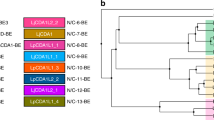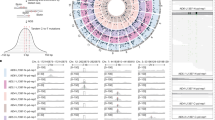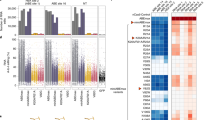Abstract
Transcription-activator-like effector (TALE)-based tools for base editing of nuclear and organellar DNA rely on double-stranded DNA deaminases, which edit substrate bases on both strands of DNA, reducing editing precision. Here, we present CyDENT base editing, a CRISPR-free, strand-selective, modular base editor. CyDENT comprises a pair of TALEs fused with a FokI nickase, a single-strand-specific cytidine deaminase and an exonuclease to generate a single-stranded DNA substrate for deamination. We demonstrate effective base editing in nuclear, mitochondrial and chloroplast genomes. At certain mitochondrial sites, we show editing efficiencies of 14% and strand specificity of 95%. Furthermore, by exchanging the CyDENT deaminase with one that prefers editing GC motifs, we demonstrate up to 20% mitochondrial base editing at sites that are otherwise inaccessible to editing by other methods. The modular nature of CyDENT enables a suite of bespoke base editors for various applications.
This is a preview of subscription content, access via your institution
Access options
Access Nature and 54 other Nature Portfolio journals
Get Nature+, our best-value online-access subscription
$29.99 / 30 days
cancel any time
Subscribe to this journal
Receive 12 print issues and online access
$209.00 per year
only $17.42 per issue
Buy this article
- Purchase on Springer Link
- Instant access to full article PDF
Prices may be subject to local taxes which are calculated during checkout





Similar content being viewed by others
Data availability
The deep amplicon sequencing data are deposited at the NCBI as Bioproject PRJNA957099 and PRJNA957096 ref. 54. All other data are available in the paper or Supplementary Information.
References
Boore, J. L. Animal mitochondrial genomes. Nucleic Acids Res. 27, 1767–1780 (1999).
Tuppen, H. A., Blakely, E. L., Turnbull, D. M. & Taylor, R. W. Mitochondrial DNA mutations and human disease. Biochim. Biophys. Acta 1797, 113–128 (2010).
Greaves, L. C., Reeve, A. K., Taylor, R. W. & Turnbull, D. M. Mitochondrial DNA and disease. J. Pathol. 226, 274–286 (2012).
Jinek, M. et al. A programmable dual-RNA-guided DNA endonuclease in adaptive bacterial immunity. Science 337, 816–821 (2012).
Ran, F. A. et al. Genome engineering using the CRISPR–Cas9 system. Nat. Protoc. 8, 2281–2308 (2013).
Shan, Q. et al. Targeted genome modification of crop plants using a CRISPR–Cas system. Nat. Biotechnol. 31, 686–688 (2013).
Gaudelli, N. M. et al. Programmable base editing of A•T to G•C in genomic DNA without DNA cleavage. Nature 551, 464–471 (2017).
Komor, A. C., Kim, Y. B., Packer, M. S., Zuris, J. A. & Liu, D. R. Programmable editing of a target base in genomic DNA without double-stranded DNA cleavage. Nature 533, 420–424 (2016).
Zong, Y. et al. Precise base editing in rice, wheat and maize with a Cas9-cytidine deaminase fusion. Nat. Biotechnol. 35, 438–440 (2017).
Anzalone, A. V. et al. Search-and-replace genome editing without double-strand breaks or donor DNA. Nature 576, 149–157 (2019).
Lin, Q. et al. Prime genome editing in rice and wheat. Nat. Biotechnol. 38, 582–585 (2020).
Yarnall, M. T. N. et al. Drag-and-drop genome insertion of large sequences without double-strand DNA cleavage using CRISPR-directed integrases. Nat. Biotechnol. 41, 500–512 (2023).
Sun, C. et al. Precise integration of large DNA sequences in plant genomes using PrimeRoot editors. Nat. Biotechnol. https://doi.org/10.1038/s41587-023-01769-w (2023).
Mok, B. Y. et al. A bacterial cytidine deaminase toxin enables CRISPR-free mitochondrial base editing. Nature 583, 631–637 (2020).
Lee, S., Lee, H., Baek, G. & Kim, J. S. Precision mitochondrial DNA editing with high-fidelity DddA-derived base editors. Nat. Biotechnol. 41, 378–386 (2022).
Kang, B. C. et al. Chloroplast and mitochondrial DNA editing in plants. Nat. Plants 7, 899–905 (2021).
Lei, Z. et al. Mitochondrial base editor induces substantial nuclear off-target mutations. Nature 606, 804–811 (2022).
Cho, S. I. et al. Targeted A-to-G base editing in human mitochondrial DNA with programmable deaminases. Cell 185, 1764–1776 (2022).
Yin, L., Shi, K. & Aihara, H. Structural basis of sequence-specific deamination by double-stranded DNA deaminase toxin DddA. Nat. Struct. Mol. Biol. https://doi.org/10.1038/s41594-023-01034-3 (2023).
Wah, D. A., Hirsch, J. A., Dorner, L. F., Schildkraut, I. & Aggarwal, A. K. Structure of the multimodular endonuclease FokI bound to DNA. Nature 388, 97–100 (1997).
Bitinaite, J., Wah, D. A., Aggarwal, A. K. & Schildkraut, I. FokI dimerization is required for DNA cleavage. Proc. Natl Acad. Sci. USA 95, 10570–10575 (1998).
Miller, J. C. et al. An improved zinc-finger nuclease architecture for highly specific genome editing. Nat. Biotechnol. 25, 778–785 (2007).
Szczepek, M. et al. Structure-based redesign of the dimerization interface reduces the toxicity of zinc-finger nucleases. Nat. Biotechnol. 25, 786–793 (2007).
Waugh, D. S. & Sauer, R. T. Single amino acid substitutions uncouple the DNA binding and strand scission activities of Fok I endonuclease. Proc. Natl Acad. Sci. USA 90, 9596–9600 (1993).
Lee, B. I., Shannon, M., Stubbs, L. & Wilson, D. M. 3rd Expression specificity of the mouse exonuclease 1 (mExo1) gene. Nucleic Acids Res. 27, 4114–4120 (1999).
Certo, M. T. et al. Coupling endonucleases with DNA end-processing enzymes to drive gene disruption. Nat. Methods 9, 973–975 (2012).
Chen, M. J., Ma, S. M., Dumitrache, L. C. & Hasty, P. Biochemical and cellular characteristics of the 3′ → 5′ exonuclease TREX2. Nucleic Acids Res. 35, 2682–2694 (2007).
Zong, Y. et al. Efficient C-to-T base editing in plants using a fusion of nCas9 and human APOBEC3A. Nat. Biotechnol. 36, 950–953 (2018).
Gehrke, J. M. et al. An APOBEC3A-Cas9 base editor with minimized bystander and off-target activities. Nat. Biotechnol. 36, 977–982 (2018).
Sanders, K. L., Catto, L. E., Bellamy, S. R. & Halford, S. E. Targeting individual subunits of the FokI restriction endonuclease to specific DNA strands. Nucleic Acids Res. 37, 2105–2115 (2009).
Li, R. et al. High-efficiency plastome base-editing in rice with TAL cytosine deaminase. Mol. Plant 14, 1412–1414 (2021).
Nakazato, I. et al. Targeted base editing in the plastid genome of Arabidopsis thaliana. Nat. Plants 7, 906–913 (2021).
Jiang, Z., Yang, M., Zhang, Y., Jackson, A. O. & Li, D. In Encyclopedia of Virology 4th edn, Vol. 3 (eds Bamford, D. H. & Zickerman, M.) 420–429 (Academic Press, 2021).
Bonillo, M., Pfromm, J. & Fischer, M. D. Challenges to gene editing approaches in the retina. Klin. Monbl. Augenheilkd. 239, 275–283 (2022).
Huang, J. et al. Discovery of deaminase functions by structure-based protein clustering. Cell 186, 3182–3195 (2023).
Christian, M. et al. Targeting DNA double-strand breaks with TAL effector nucleases. Genetics 186, 757–761 (2010).
Kim, Y. et al. A library of TAL effector nucleases spanning the human genome. Nat. Biotechnol. 31, 251–258 (2013).
Nakazato, I. et al. Targeted base editing in the mitochondrial genome of Arabidopsis thaliana. Proc. Natl Acad. Sci. USA 119, e2121177119 (2022).
Mok, B. Y. et al. CRISPR-free base editors with enhanced activity and expanded targeting scope in mitochondrial and nuclear DNA. Nat. Biotechnol. 40, 1378–1387 (2022).
Mi, L. et al. DddA homolog search and engineering expand sequence compatibility of mitochondrial base editing. Nat. Commun. 14, 874 (2023).
Shimura, M. et al. Development of Leigh syndrome with a high probability of cardiac manifestations in infantile-onset patients with m.14453G > A. Mitochondrion 63, 1–8 (2022).
Wei, Y. et al. Mitochondrial base editor DdCBE causes substantial DNA off-target editing in nuclear genome of embryos. Cell Discov. 8, 27 (2022).
Nishimasu, H. et al. Crystal structure of Cas9 in complex with guide RNA and target DNA. Cell 156, 935–949 (2014).
Richter, M. F. et al. Phage-assisted evolution of an adenine base editor with improved Cas domain compatibility and activity. Nat. Biotechnol. 38, 883–891 (2020).
Yi, Z. et al. Strand-selective base editing of human mitochondrial DNA using mitoBEs. Nat. Biotechnol. https://doi.org/10.1038/s41587-023-01791-y (2023).
Shan, Q. et al. Rapid and efficient gene modification in rice and Brachypodium using TALENs. Mol. Plant 6, 1365–1368 (2013).
Jin, S., Lin, Q., Gao, Q. & Gao, C. Optimized prime editing in monocot plants using PlantPegDesigner and engineered plant prime editors (ePPEs). Nat. Protoc. 18, 831–853 (2023).
Chen, S. Ultrafast one‐pass FASTQ data preprocessing, quality control, and deduplication using fastp. iMeta 2, e107 (2023).
Li, H. & Durbin, R. Fast and accurate long-read alignment with Burrows–Wheeler transform. Bioinformatics 26, 589–595 (2010).
Tarasov, A., Vilella, A. J., Cuppen, E., Nijman, I. J. & Prins, P. Sambamba: fast processing of NGS alignment formats. Bioinformatics 31, 2032–2034 (2015).
Van der Auwera, G. A. et al. From FastQ data to high confidence variant calls: the genome analysis toolkit best practices pipeline. Curr. Protoc. Bioinformatics 43, 11.10.1–11.10.33 (2013).
Danecek, P. et al. Twelve years of SAMtools and BCFtools. Gigascience 10, 1–4 (2021).
Bae, S., Park, J. & Kim, J. S. Cas-OFFinder: a fast and versatile algorithm that searches for potential off-target sites of Cas9 RNA-guided endonucleases. Bioinformatics 30, 1473–1475 (2014).
Hu, J. et al. Strand-selective base editing of organellar and nuclear genomes with TALE fusions. National Center for Biotechnology Information (NCBI) https://www.ncbi.nlm.nih.gov/bioproject/PRJNA957096 (2023).
Acknowledgements
We thank Y. Ai for kindly providing the HEK293T cell line. We also thank C. Yi for providing DdCBE vectors targeting ND1, ND4, ND5.1 and ND6. We are grateful to Y. Wang for the helpful discussions. We acknowledge Y. Li for assistance with figure drawing. We thank J. Huang at BGI Genomics for the whole-genome sequencing service. This work was supported by the Ministry of Agriculture and Rural Affairs of China, the Strategic Priority Research Program of the Chinese Academy of Sciences (Precision Seed Design and Breeding, XDA24020102), the National Key Research and Development Program (2022YFF1002802) and the National Natural Science Foundation of China (32388201).
Author information
Authors and Affiliations
Contributions
J.H., K.T.Z. and C.G. conceived the project and designed the experiments; J.H. designed vectors and tested mtCyDENT in HEK293T cells; Y.S. and B.L. designed vectors and tested nuCyDENT and cpCyDENT in plants; J.H. and Y.S. collected and analyzed MiSeq data; J.H., Y.S. and G.L. prepared MiSeq samples; Z.L. and M.G. prepared plasmids and HEK293T cells; Z.W. and Q.G. wrote scripts and processed the MiSeq RAW data; Q.G. processed the whole-genome sequencing RAW data; J.H., Y.S. and B.L. prepared the figures; J.H., Y.S., B.L., K.T.Z. and C.G. wrote the manuscript with input from all authors; and C.G. and K.T.Z. supervised the study.
Corresponding authors
Ethics declarations
Competing interests
The authors have submitted a patent application based on the results reported in this paper. K.T.Z. is a founder and employee at Qi Biodesign. Z.L., Z.W., Q.G. and M.G. are employees of Qi Biodesign.
Peer review
Peer review information
Nature Biotechnology thanks the anonymous reviewers for their contribution to the peer review of this work.
Additional information
Publisher’s note Springer Nature remains neutral with regard to jurisdictional claims in published maps and institutional affiliations.
Supplementary information
Supplementary Information
Supplementary Figs. 1–5, Supplementary Tables 1–5, Supplementary Code, Supplementary Sequences and Supplementary Refs.
Rights and permissions
Springer Nature or its licensor (e.g. a society or other partner) holds exclusive rights to this article under a publishing agreement with the author(s) or other rightsholder(s); author self-archiving of the accepted manuscript version of this article is solely governed by the terms of such publishing agreement and applicable law.
About this article
Cite this article
Hu, J., Sun, Y., Li, B. et al. Strand-preferred base editing of organellar and nuclear genomes using CyDENT. Nat Biotechnol (2023). https://doi.org/10.1038/s41587-023-01910-9
Received:
Accepted:
Published:
DOI: https://doi.org/10.1038/s41587-023-01910-9
This article is cited by
-
Targeted genome-modification tools and their advanced applications in crop breeding
Nature Reviews Genetics (2024)
-
TALE-based organellar genome editing and gene expression in plants
Plant Cell Reports (2024)
-
CRISPR/Cas-mediated germplasm improvement and new strategies for crop protection
Crop Health (2024)



